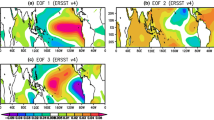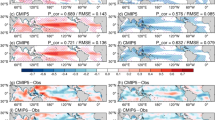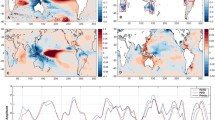Abstract
Spectral analysis of global-mean precipitation, P, evaporation, E, precipitable water, W, and surface temperature, Ts, revealed significant variability from sub-daily to multi-decadal time-scales, superposed on high-amplitude diurnal and yearly peaks. Two distinct regimes emerged from a transition in the spectral exponents, β. The weather regime covering time-scales < ~ 10 days with β ≥ 1; and the macroweather regime extending from a few months to a few decades with 0 <β <1. Additionally, the spectra showed a generally good statistical agreement amongst several different model- and satellite-based datasets. Detrended cross-correlation analysis (DCCA) revealed three important results which are robust across all datasets: (1) Clausius–Clapeyron (C–C) relationship is the dominant mechanism of W non-periodic variability at multi-year time-scales; (2) C–C is not the dominant control of W, P or E non-periodic variability at time-scales below about 6 months, where the weather regime is approached and other mechanisms become important; (3) C–C is not a dominant control for P or E over land throughout the entire time-scale range considered. Furthermore, it is suggested that the atmosphere and oceans start to act as a single coupled system at time-scales > ~ 1–2 years, while at time-scales < ~ 6 months they are not the dominant drivers of each other. For global-ocean and full-globe averages, ρDCCA showed large spread of the C–C importance for P and E variability amongst different datasets at multi-year time-scales, ranging from negligible (< 0.3) to high (~ 0.6–0.8) values. Hence, state-of-the-art climate datasets have significant uncertainties in the representation of macroweather precipitation and evaporation variability and its governing mechanisms.









Similar content being viewed by others
References
Adler RF et al. (2003) The version-2 global precipitation climatology project (GPCP) monthly precipitation analysis (1979–present). J Hydrometeorol 4(6):1147–1167. https://doi.org/10.1175/1525-7541(2003)004<1147:TVGPCP>2.0.CO;2
Adler RF, Gu G, Wang J-J, Huffman GJ, Curtis S, Bolvin D (2008) Relationships between global precipitation and surface temperature on interannual and longer timescales (1979–2006). J Geophys Res 113:D22104. https://doi.org/10.1029/2008JD10536
Adler RF, Gu G, Sapiano M et al (2017) Global precipitation: means, variations and trends during the satellite era (1979–2014). Surv Geophys 38:679–699. https://doi.org/10.1007/s10712-017-9416-4
Allan RP, Soden BJ, John VO, Ingram W, Good P (2010) Current changes in tropical precipitation. Environ Res Lett 5(2):025205. https://doi.org/10.1088/1748-9326/5/2/025205
Allen MR, Ingram WJ (2002) Constraints on future changes in climate and the hydrological cycle. Nature 419:224–232
Andersson A et al (2010) The Hamburg ocean atmosphere parameters and fluxes from satellite data—HOAPS-3. Earth Syst Sci Data Discuss 3:143–194
Barros AP, Kim G, Williams E, Nesbitt SW (2004) Probing orographic controls in the Himalayas during the monsoon using satellite imagery. Nat Hazards Earth Syst Sci 4(1):29–51
Betts AK (1998) Climate-convection feedbacks: some further issues. Clim Change 39:35–38
Boer GJ (1993) Climate change and the regulation of the surface moisture and energy budgets. Clim Dyn 8:225–239
Bosilovich MG, Robertson FR, Takacs L, Molod A, Mocko D (2017) Atmospheric water balance and variability in the MERRA-2 reanalysis. J Clim 30:1177–1196. https://doi.org/10.1175/JCLI-D-16-0338.1
Caballero R, Hanley J (2012) Midlatitude eddies, storm-track diffusivity, and poleward moisture transport in warm climates. J Atmos Sci 69:3237–3250. https://doi.org/10.1175/JAS-D-12-035.1
Chenhua S (2015) Analysis of detrended time-lagged cross-correlation between two nonstationary time series. Phys Lett A 379:680–687. https://doi.org/10.1016/j.physleta.2014.12.036
Compo GP, Whitaker JS, Sardeshmukh PD, Matsui N, Allan RJ, Yin X, Gleason BE, Vose RS, Rutledge G, Bessemoulin P, Brönnimann S, Brunet M, Crouthamel RI, Grant AN, Groisman PY, Jones PD, Kruk MC, Kruger AC, Marshall GJ, Maugeri M, Mok HY, Nordli Ø, Ross TF, Trigo RM, Wang XL, Woodruff SD, Worley SJ (2011) The twentieth century reanalysis project. Q J R Meteorol Soc 137:1–28. https://doi.org/10.1002/qj.776
de Lima MIP, Lovejoy S (2015) Macroweather precipitation variability up to global and centennial scales. Water Resour Res 51:9490–9513. https://doi.org/10.1002/2015WR017455
Fraedrich K, Blender R (2003) Scaling of atmosphere and ocean temperature correlations in observations and climate models. Phys Rev Lett 90:108510. https://doi.org/10.1103/PhysRevLett.90.108501
Fredriksen H, Rypdal K (2016) Spectral characteristics of instrumental and climate model surface temperatures. J Clim 29:1253–1268. https://doi.org/10.1175/JCLI-D-15-0457.1
Gehne M, Hamill TM, Kiladis GN, Trenberth KE (2016) Comparison of global precipitation estimates across a range of temporal and spatial scales. J Clim 29:7773–7795. https://doi.org/10.1175/JCLI-D-15-0618.1
Gu G, Adler RF (2011a) Precipitation and temperature variations on the interannual time scale: assessing the impact of ENSO and volcanic eruptions. J Clim 24:2258–2270
Gu G, Adler RF (2012) Large-scale, inter-annual relations among surface temperature, water vapour and precipitation with and without ENSO and volcano forcings. Int J Climatol 32:1782–1791. https://doi.org/10.1002/joc.2393
Gu G, Adler RF (2013) Interdecadal variability/long-term changes in global precipitation patterns during the past three decades: global warming and/or Pacific decadal variability? Clim Dyn 40:3009–3022. https://doi.org/10.1007/s00382-012-1443-8
Gu G, Adler RF, Huffman GJ, Curtis S (2007) Tropical rainfall variability on interannual-to-interdecadal and longer time scales derived from the GPCP monthly product. J Clim 20:4033–4046. https://doi.org/10.1175/JCLI4227.1
Gutowski WJ, Decker SG, Donavon RA, Pan Z, Arritt RW, Takle ES (2003) Temporal-spatial scales of observed and simulated precipitation in central US climate. J Clim 16:3841–3847. https://doi.org/10.1175/1520-0442(2003)0163841:TSOOAS2.0.CO;2
Hansen J, Ruedy R, Sato M, Lo K (2010) Global surface temperature change. Rev Geophys 48:RG4004. https://doi.org/10.1029/2010RG000345
Held IM, Soden BJ (2006) Robust responses of the hydrological cycle to global warming. J Clim 19:5686–5699
Henriksson SV et al (2015) Improved power-law estimates from multiple samples provided by millennium climate simulations. Theor Appl Climatol 119:667–677. https://doi.org/10.1007/s00704-014-1132-0
Hersbach H, Peubey C, Simmons A, Berrisford P, Poli P, Dee DP (2015) ERA-20CM: a twentieth century atmospheric model ensemble. Q J R Meteorol Soc 141:2350–2375. https://doi.org/10.1002/qj.2528
Horvatic D, Stanley HE, Podobnik B (2011) Detrended cross-correlation analysis for non-stationary time-series with periodic trends. Europhys Lett 94:18007
Huybers P, Curry W (2006) Links between annual, Milankovitch and continuum temperature variability. Nature 441:329–332
Kantelhardt JW, Zschiegne SA, Koscielny-Bunde E, Havlin S, Bunde A, Stanley HE (2002) Multifractal detrended fluctuation analysis of nonstationary time-series. Phys A 316:87–114
Kidd C, Bauer P, Turk J, Huffman GJ, Joyce R, Hsu KL, Braithwaite D (2012) Inter-comparison of high-resolution precipitation products over northwest Europe. J Hydrometeor 13(1):67–83. https://doi.org/10.1175/JHM-D-11-042.1
Laloyaux P, Balmaseda M, Dee D, Mogensen K, Janssen P (2016) A coupled data assimilation system for climate reanalysis. QJR Meteorol Soc 142:65–78. https://doi.org/10.1002/qj.2629
Levine XJ, Boos WR (2016) A mechanism for the response of the zonally asymmetric subtropical hydrologic cycle to global warming. J Clim 29:7851–7867. https://doi.org/10.1175/JCLI-D-15-0826.1
Liu C, Allan RP (2012) Multisatellite observed responses of precipitation and its extremes to interannual climate variability. J Geophys Res 117:D03101. https://doi.org/10.1029/2011JD016568
Lorenz C, Kunstmann H (2012) The hydrological cycle in threestate-of-the-art reanalyses: intercomparison and performance analysis. J Hydrometeor 13:1397–1420. https://doi.org/10.1175/JHM-D-11-088.1
Lovejoy S (2015) A voyage through scales, a missing quadrillion and why the climate is not what you expect. Clim Dyn 44:3187–3210
Lovejoy S, Schertzer D (2013) The weather and climate: emergent laws and multifractal cascades. Cambridge University Press, Cambridge
Lovejoy S, Del Rio Amador L, Hébert R (2017) Harnessing butterflies: theory and practice of the stochastic seasonal to interannual prediction system (StocSIPS). In: Tsonis A (ed) Advances in nonlinear geosciencs. Springer, Cham
Morice CP, Kennedy JJ, Rayner NA, Jones PD (2012) Quantifying uncertainties in global and regional temperature change using an ensemble of observational estimates: the HadCRUT4 dataset. J Geophys Res 117:D08101. https://doi.org/10.1029/2011JD017187
Nogueira M (2017a) Exploring the link between multiscale entropy and fractal scaling behavior in near-surface wind. PLoS One 12(3):e0173994. https://doi.org/10.1371/journal.pone.0173994
Nogueira M (2017b) Exploring the links in monthly to decadal variability of the atmospheric water balance over the wettest regions in ERA-20C. J Geophys Res Atmos. https://doi.org/10.1002/2017JD027012
Nogueira M, Barros AP (2015) Transient stochastic downscaling of quantitative precipitation estimates for hydrological applications. J Hydrol 529(3):1407–1421
O’Gorman PA, Muller CG (2010) How closely do changes in surface and column water vapour follow Clausius–Clapeyron scaling in climate change simulations? Environ Res Lett 5:025207
O’Gorman PA, Schneider T (2008) The hydrological cycle over a wide range of climates simulated with an idealized GCM. J Clim 21:3815–3832. https://doi.org/10.1175/2007JCLI2065.1
Pelletier J (2002) Natural variability of atmospheric temperatures and geomagnetic intensity over a wide range of time scales. PNAS 99:2546–2553
Piao L, Fu Z (2016) Quantifying distinct associations on different temporal scales: comparison of DCCA and Pearson methods. Sci Rep 6:36759. https://doi.org/10.1038/srep36759
Podobnik B, Stanley HE (2008) Detrended cross-correlation analysis: a new method for analyzing twononstationary time-series. Phys Rev Lett 100:084102
Podobnik B, Jiang Z, Zhou W, Stanley HE (2011) Statistical tests for power-law cross-correlated processes. Phys Rev E 84:066118
Poli P et al (2016) ERA-20C: an atmospheric reanalysis of the twentieth century. J Clim 29:4083–4097. https://doi.org/10.1175/JCLI-D-15-0556.1
Rybski D, Bunde A, von Storch H (2008) Long-term memory in 1000-year simulated temperature records. J Geophys Res 113:D02106. https://doi.org/10.1029/2007JD008568
Schneider T, O’Gorman PA, Levine XJ (2010) Water vapor and the dynamics of climate changes. Rev Geophys 48:RG3001. https://doi.org/10.1029/2009RG000302
Singleton A, Toumi R (2013) Super-Clausius–Clapeyron scaling of rainfall in a model squall line. Q J R Meteorol Soc 139:334–339
Sohn BJ, Han H-J, Seo E-K (2010) Validation of satellite-based high-resolution rainfall products over the Korean peninsula using data from a dense rain gauge network. J Appl Meteor Climatol 49(4):701–714. https://doi.org/10.1175/2009JAMC2266.1
Stephens GL, Ellis TD (2008) Controls of global-mean precipitation increases in global warming GCM experiments. J Clim 21:6141–6155. https://doi.org/10.1175/2008JCLI2144.1
Trenberth KE (1998) Atmospheric moisture residence times and cycling: implications for rainfall rates with climate change. Clim Change 39:667–694
Trenberth KE (2011) Changes in precipitation with climate change. Clim Res 47:123–138
Trenberth KE, Fasullo J, Smith L (2005) Trends and variability in column-integrated atmospheric water vapor. Clim Dyn 24:741–758
Trenberth KE, Fasullo JT, Mackaro J (2011) Atmospheric moisture transports from ocean to land and global energy flows in reanalyses. J Clim 24:4907–4924. https://doi.org/10.1175/2011JCLI4171.1
Vyushin DI, Kushner PJ (2009) Power–law and long-memory characteristics of the atmospheric general circulation. J Clim 22:2890–2904
Vyushin DI, Kushner PJ, Mayer J (2009) On the origins of temporal power–law behavior in the global atmospheric circulation. Geophys Res Lett 36:L14706. https://doi.org/10.1029/2009GL038771
Wentz FJ (1997) A well-calibrated ocean algorithm for SSM/I. J Geophys Res 102(C4):8703–8718
Wentz FJ, Schabel M (2000) Precise climate monitoring using complementary satellite data sets. Nature 403:414–416
Wentz F, Ricciardulli L, Mears C (2007) How much more rain will global warming bring? Science 317:233–235
Whitaker JS, Hamill TM (2002) Ensemble data assimilation without perturbed observations. Mon Weather Rev 130:1913–1924. https://doi.org/10.1175/1520-0493(2002)130<1913:EDAWPO>2.0.CO;2
**e P, Arkin PA (1997) Global precipitation: a 17-year monthly analysis based on gauge observations, satellite estimates, and numerical model outputs. Bull Am Meteorol Soc 78:2539–2558
Acknowledgements
This study was funded by the Portuguese Science Foundation (FCT), under Grant UID/GEO/50019/2013, as part of Research Project SOLAR (PTDC/GEOMET/7078/2014). All the datasets used in the present investigation are freely available. ERA-20C, ERA-20CM and CERA-20C products were provided by ECMWF and are available through the website http://apps.ecmwf.int/datasets. 20CR reanalysis, and GPCP and CMAP precipitation products were provided by the NOAA/OAR/ESRL PSD, Boulder, Colorado, USA, from their website at http://www.esrl.noaa.gov/psd. HOAPS precipitation and evaporation datasets were provided by EUMETSAT through the website http://wui.cmsaf.eu. RSS monthly mean precipitable water product was provided by Remote Sensing Systems Version-8 Microwave Radiometer Data, Santa Rosa, CA, USA, from their website http://www.remss.com.
Author information
Authors and Affiliations
Corresponding author
Rights and permissions
About this article
Cite this article
Nogueira, M. The sensitivity of the atmospheric branch of the global water cycle to temperature fluctuations at synoptic to decadal time-scales in different satellite- and model-based products. Clim Dyn 52, 617–636 (2019). https://doi.org/10.1007/s00382-018-4153-z
Received:
Accepted:
Published:
Issue Date:
DOI: https://doi.org/10.1007/s00382-018-4153-z




